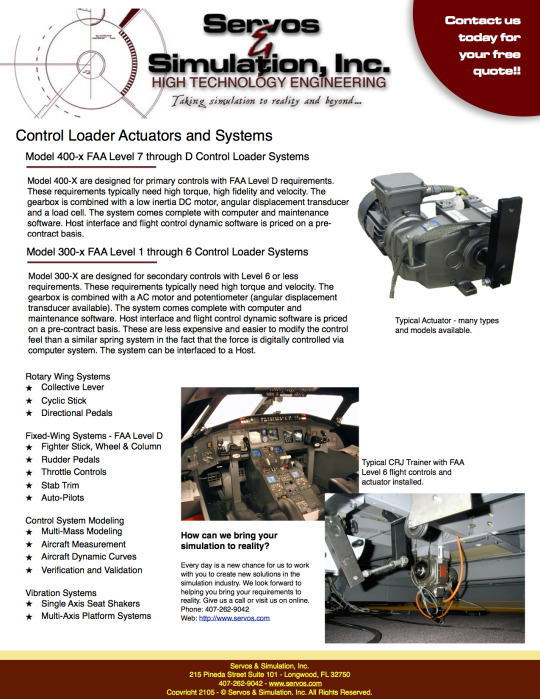#feedbackcontrolloader controlloader simulation simulator servosandsimulation
Explore tagged Tumblr posts
Text
What is the Real Cost of Upgrading a Feedback Control System?
Quite often, when systems are upgraded either for reasons of replacing parts that are no longer in the support system or improving performance, the cost of supporting the new system is neglected.
What sort of support from the manufacturer is available and at what cost?
What is the MTBF of the new equipment?
Is there any on-going maintenance that must be performed on a regular basis?
Such things make an inexpensive purchase price end up costing much more than a higher priced unit.
An excellent example covering the "Buying a Motion Platform" may be found at the following link:https://www.linkedin.com/pulse/ultimate-checklist-buying-motion-platform-rachel-baker
Since that covers the motion system quite thoroughly, let's talk about the feedback control loading of the flight stick, yokes, pedals, throttle, toe brakes and the like of non-fly-by-wire simulators.

Many of the same performance factors of motion bases need to be addressed in regarding to feedback control loading systems.
Feedback Control Loaders can be very inexpensive for simulators that require little or no FAA approval. Such loaders can be considered simple springs; you pull or push on a control and it reacts as a spring or bungee cord. These are what could be referred to as "Entertainment" loaders and can be purchased for well under $500 USD but in no way qualify as Feedback Control Loaders for pilot training in a simulator.
As the quality (or rating) of the simulator systems increases, how much fidelity the system has becomes more and more important. A good read on the Psychology of Simulation can be found in R. T. Hays/M.M. Singer's book "Simulation Fidelity in Training System Design" subtitled "Bridging the Gap Between Reality and Training.”
The bottom line - the simulator must represent what the aircraft or mechanical device feels like when in actual operation. Whatever the pilot/operator is trained to do in the simulator, it must represent exactly what it is in real life. If the pilot/operator is told, during training, to not pay attention to that "buzzy" feel might lead to that buzzy noise of an off-balance turbine being written off as normal resulting in death or injury in real life. This is why fidelity of the Feedback Control Loader is crucial. Thus, we get back to the fidelity as Hays' book references. Poor fidelity equals poor performance.
So, what is GOOD fidelity? For that, let's refer to FAA Class A and higher full-flight simulators. The one performance factor that describes the whole thing is the throughput of the system… i.e. how fast can the system take a sample, do math on the sample and output the result repetitively?
Servo feedback control engineers typically agree that the higher the throughput is of a system, the easier it is to stabilize the servo which keeps the servo stable in a system. As the frequency of samples decreases, the servo loses its ability to subdue inherent instabilities of the system such as noise, springiness of linkages, slop (loose bearings) in connecting rods etc. As a minimum, 4,000Hz would be suggested here and higher if possible. Bottom line is this, a poorly design Feedback Control Loader is going to be with you for a long, long time. At what cost to pilot training, maintenance and upgrades will this affect the entire simulator program as a whole.
(1 - non-moving numerical ratings 1 thru 7 and moving ratings A thru D with “D” being the highest rated)
For more information on our Feedback Control Loader or Motion Base Platform product lines, please visit our web site at www.servos.com.
1 note
·
View note